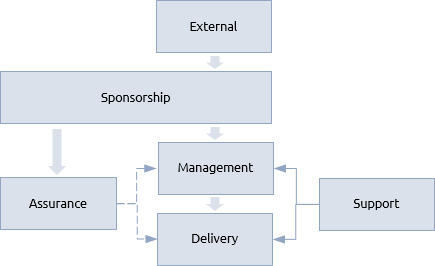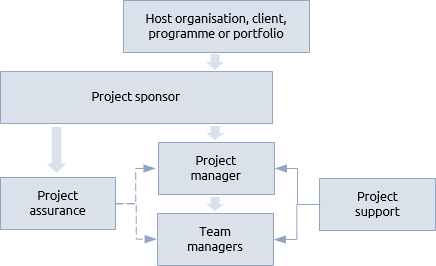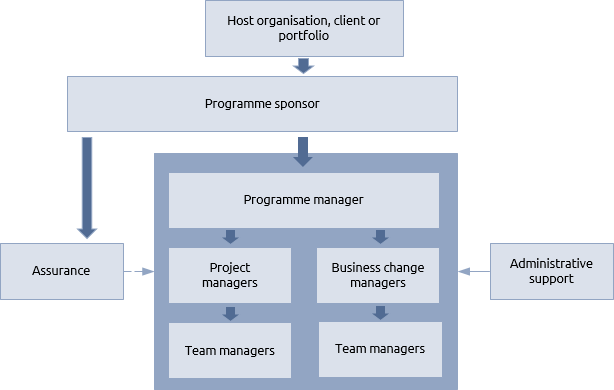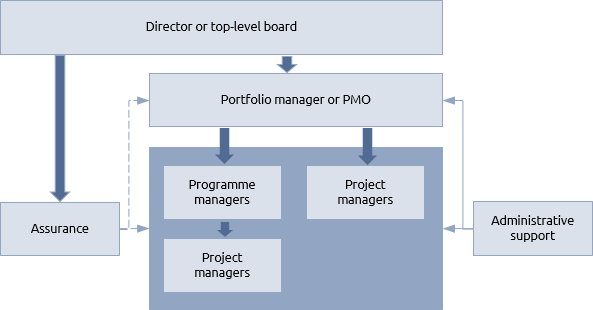General
Organisation management is concerned with creating and maintaining a management structure applicable to the project, programme or portfolio and the context in which it operates. Its goals are to:
- design an organisation appropriate to the scope of work to be managed;
- identify and appoint members of the management team;
- maintain and adapt the organisation throughout the life cycle.
The procedure for managing the organisation is a simple one:

Planning for organisation management includes the design of an organisation structure that will match the context and scope of the work. This will include the description of policies for appointing staff and cross-reference the relevant host-organisation HR policies.
There is a strong correlation between the initiate and close steps in organisation management and the mobilise and de-mobilise steps in mobilisation.
The difference is simply that organisation management deals with the management team and mobilisation deals with delivery resources.
The initiate step involves making appointments and delivering any necessary training.
The demands on the organisation structure will usually change during the course of the project or programme life cycle. The organisation must be amended to take these changing requirements into account.
Finally the organisation is closed down and disbanded.
The organisational structure of individual projects, programmes and portfolios will vary according to the context and specific needs of each situation. In broad terms, the organisation will always have four main levels.

The external level in the organisation represents the body that first mandated the work. This could be a company mandating a portfolio; a client mandating a project; a programme mandating a project or a department mandating a programme. Whatever the nature of the external organisation it delegates responsibility for looking after its interests to the sponsorship level.
The sponsorship function, in conjunction with the sponsorship process, provides the link between the management and external levels. The sponsor champions the work and owns the business case.
The management level is where the day-to-day responsibility for managing the work resides. The sponsorship and management levels form the management team, whether it be a project, programme or portfolio management team.
The delivery level represents the staff, contractors and suppliers involved in the delivery process.
The context sensitive nature of the levels is important when Praxis makes observations about the relationships between the levels. For example in the delivery process, Praxis states that “Each delivery team will provide the management team with regular progress reports”.
This is true regardless of whether it involves a project delivery team reporting to a project management team or a project management team acting as a delivery team to a programme management team.
All the levels are relative and context sensitive. For example, the day-to-day management of a programme includes the provision of sponsorship to component projects. The programme management team will see the project management teams as their delivery teams. From the project management team’s point of view, the programme management team are their sponsors and they have delivery teams of staff and suppliers creating outputs and reporting to them.
The whole structure depends upon good delegation and control systems that ensure the appropriate level of management is involved in key decisions.
Alongside the main four level structure are assurance and support. An assurance team reports to the sponsor and provides confidence that the management and delivery of the work are being conducted effectively and appropriately, which will include adherence to the various management plans.
The support function provides administrative and technical services to both the management and delivery levels.
Some project-based organisations, typically in construction or engineering, will have people working exclusively on a particular project or programme but most host organisations are based around a departmental structure overlaid with projects and programmes known as a matrix organisation.
In a matrix organisation, delivery resources and sometimes management resources report both to their line manager and to the project or programme manager. This can create conflict between the two sources of authority and should be recognised by the host organisation.
The organisation will evolve during the life cycle. During the identification process and definition process, specialist structures may be employed, some of which may continue into the delivery process, but not necessarily so. Different stages or tranches of work may require different organisational designs.
Projects, programmes and portfolios
Adapting the standard structure for a project results in the organisation shown below:

The sponsor is an individual who may be supported by other senior managers in larger, more complex project. Such a group may be known as a project board or steering group. This is the level that is most context sensitive. For example, where the project within a programme, the programme manager may also take the role of project sponsor. In the case of a project involving a contractor and client organisation, a project board may include representatives of both.
On small projects, the support and team manager responsibilities will be taken on by the project manager. As the scale of the work increases, there will be a need for separate support resources and team managers who look after specific work packages.
The structure of the project organisation showing contractors, departments, teams and sometimes individuals is often represented by an organisational breakdown structure (OBS). This can be combined with a work breakdown structure to produce a responsibility assignment matrix (RAM).
The main addition to the basic organisation structure when managing programmes is the role of business change manager (BCM). BCMs focus on change management and benefits management to achieve the benefits set out in the business case.
The programme sponsor will usually be supported by a group of senior managers although the sponsor will still be ultimately accountable for the business case. These senior managers are sometimes known as the sponsoring group and it should comprise the senior managers from the business units most affected by the programme. This supports a close working relationship and understanding between the programme and those affected by it.

In a portfolio there are typically only three organisational levels, since the external and sponsorship levels are, in effect, one and the same thing. This external/sponsorship level is usually accountable not only for the delivery of the portfolio’s objectives but also the development of the discipline and profession of P3 management. This is described in the portfolio governance process and has parallels with the way other professional departments within a company are governed.
Ideally, someone on the main board of the organisation will represent P3 management. This will effectively make that person the sponsor of the portfolio.

The management of a portfolio is sometimes handled by a group known as a project management office (PMO). The PMO manages the portfolio and may also be responsible for the overall development and promotion of P3 management in the host organisation.
PMOs can be constituted in many different ways but in this context the PMO is synonymous with the portfolio management team.





